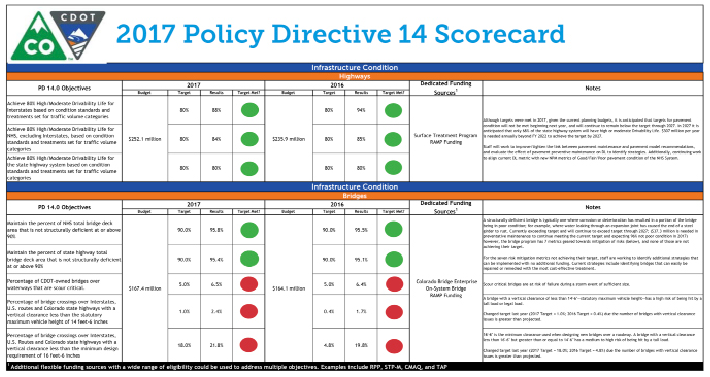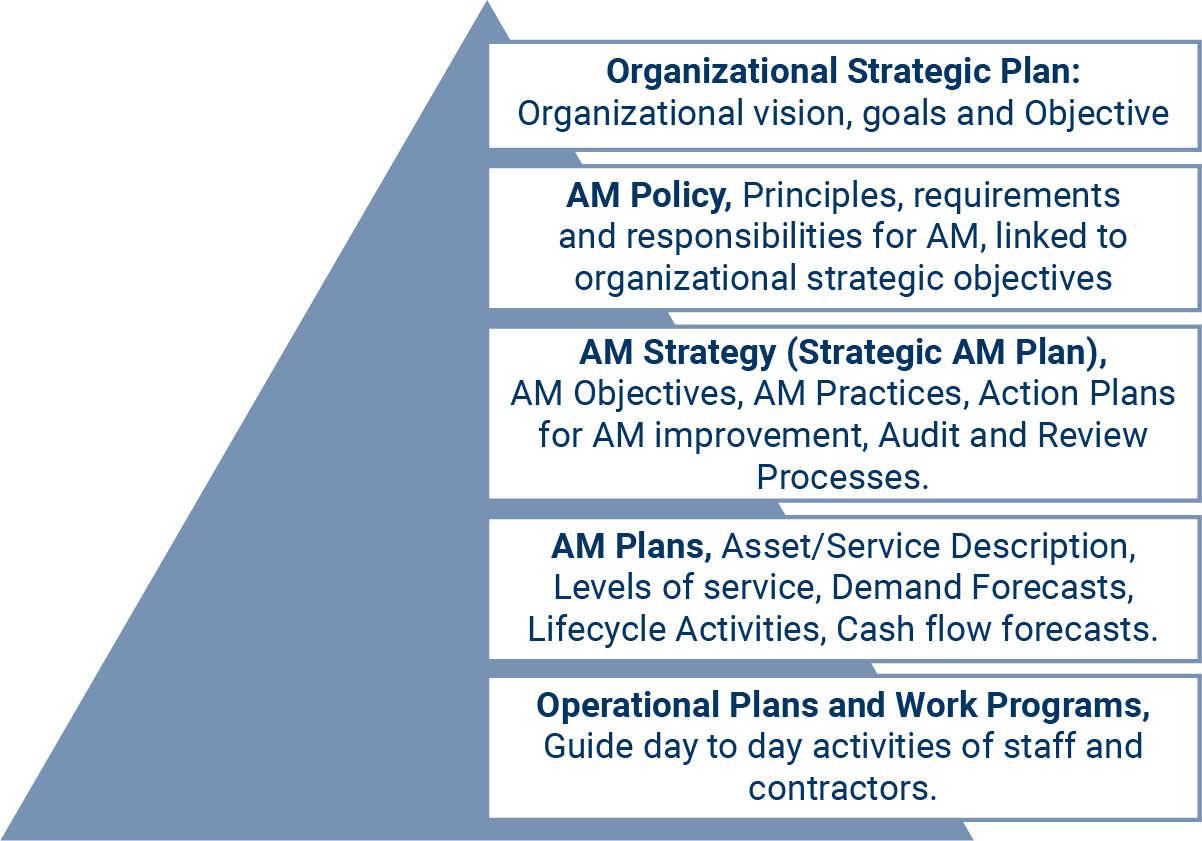- Chapters
-
Chapter 2
Sections - Chapter 2 Home Page
- Chapter PDF
Chapter 2
Quick Links
2.1.2
Creating a TAM Policy
A TAM policy describes the adoption of asset management principles for managing infrastructure. It defines the intent of the TAM program and can include how TAM will be carried out in the agency. Leadership direction on the policy helps achieve buy-in throughout the agency, making it easier to ensure it connects to and aligns with other strategic documents.
Strategic Framework for Asset Management
A TAM policy can be the first place an agency communicates the strategy of their TAM program. It can be thought of as a contract between the agency and its customers, partners and stakeholders that defines how TAM fits within the agency's decision making process.
Some elements of a TAM Policy can be included within a TAMP (TAM Objectives, Scope of TAM, connection of TAM to other planning initiatives, and TAM roles). However, a separate TAM Policy may provide those responsible for TAM within an organization the ability to challenge existing processes and approaches. A concise TAM Policy defines the principles that guide the decisions made during TAMP development and implementation.
A TAM Policy can outline the types of assets considered for management and identify where in the cycle of DOT work activities to emphasize asset management practices. It can also establish the high-priority initiatives on which the agency will focus their efforts. A TAM policy starts to set boundaries and clarify the intent of asset management.
A TAM policy may include:
- Definitions of services provided to customers and distinctions between service levels
- Approaches for managing assets from a whole life perspective
- Decision-making standards, based on the triple bottom line (economic, environmental, and social)
- Consideration of risk
- Approach for making transparent, data- driven decisions
For further details on developing a TAM Policy, see the how-to guide in this chapter.
Oklahoma DOT
The Oklahoma DOT identified the following TAM objectives to help guide their asset management program:
- Maintain (improve) the condition of the state’s bridges and roadways
- Reduce risk associated with asset performance
- Make better data driven decisions about assets
- Reduce costs and improve efficiency, including effectively delivering projects that support asset management
- Increase internal and external communications and transparency
- Improve customer service
- Improve safety on the state’s transportation system
- Enhance mobility of people and goods
TAM Goals, Objectives, Strategies
TAM goals and objectives support and communicate the policy and align with the broader agency vision, mission, goals and strategies. Goals and objectives may cover transportation system performance and desired outcomes, as well as agency decision-making approaches and practices. Some agencies have goals and objectives, while some have only goals and others have only objectives. Regardless of the terminology that is used, it is important that agencies set a vision and establish a direction to move towards. The Oklahoma DOT practice example highlights their TAM objectives.
Agencies should include a clear statement of TAM principles – either within the agency’s strategic documents or as a stand-alone policy. They should also seek opportunities to strengthen the integration of TAM within the agency’s strategic planning efforts.
TIP
A TAM Policy can be a sign of leadership commitment to implementing asset management. A good policy is clear, concise, and easy to interpret.
Ingredients for Success in Creating a TAM Policy
The following are some of the key ingredients that make a TAM policy successful.
Leadership Support
Leadership support and direction in the effort to create a TAM policy is important. Effective leadership ensures and maintains a connection across the various types of goals. A typical transportation agency has a lot of moving parts and multiple, sometimes conflicting, priorities. The nature of TAM and its success in meeting TAM goals involves actions that cut across individual business units. Leadership is a critical ingredient in creating positive change and maintaining processes across business units. See section 3.1 for more information on leadership.
Internal and External Stakeholder Engagement and Support
Involving groups and people who want a voice in the TAM program’s success, whether external partners or stakeholders or internal business units, is important for creating policies that will have a positive impact and are sustainable. See section 3.2 for more on stakeholder engagement.
Consider Implementation
There may be multiple ways to accomplish policy objectives, so the policy should be simple and flexible rather than complex and rigid.
Link to Performance Management
Performance management is an underlying component of good asset management. Policies should consider the ability to define performance measures, collect data and measure performance. They should also consider the cycle of setting objectives, monitoring performance and making adjustments. See section 2.2 for more on TAM performance and monitoring.
Amtrak
Amtrak’s Engineering Asset Management policy identifies guiding principles that the agency intends to use in managing the infrastructure it owns and maintains. Specifically, the policy focuses on developing asset management capability and implementing the TAMP. The policy begins with a purpose statement that defines asset management, and then lays out seven principles (or standards) to guide asset management practice. The principles highlight ownership, transparency, risk management, life cycle costs and information systems standards for Amtrak’s asset management practice. In addition, the policy also identifies responsibilities and leadership commitment, calling out specific positions in the agency and their role in delivering the asset management plan. The policy is included as a section in their asset management plan and is signed by the President and CEO, EVP Chief Operating Officer, and VP Chief Engineer.
TAM Principles
FHWA Principles of Asset Management
FHWA has defined a number of basic principles for asset management as listed below. All of these ideas work together to help an agency make decisions to better address their infrastructure needs. Asset management should be:
Policy driven. Decisions reflect policy goals and objectives that define desired system condition and service levels.
Performance based. Performance information is used to establish target levels, to allocate funding, and to monitor progress.
Risk based. Risk management is used to identify, analyze, evaluate and address the risks to assets and system performance.
Option oriented. Comprehensive choices and trade-offs are examined at each level of decision making.
Data driven. Management systems and tools that utilize quality data are used to support decisions.
Transparent. There are clear criteria for making decisions.
Seattle DOT
Seattle is one of the fastest growing cities in the U.S. and the demands on the transportation system have grown dramatically. Meanwhile, the system is aging. Seattle DOT (SDOT) needed to find a way to balance infrastructure expansion, preservation, and maintenance by aligning its Asset Management practices with its service delivery strategies. All of this had to occur within the limits of available resources and ensure that SDOT strategically managed the transportation system for years to come. SDOT’s Asset Management initiative provides a long-term vision of how SDOT intends to accomplish its mission. In 2007, the SDOT began implementation of Asset Management, a strategic and systematic process that guides decisions about construction, maintenance, and operation of SDOT infrastructure. The SDOT identified and adopted the following three key principles of asset management principles:
- Build, preserve, and operate transportation infrastructure services more cost effectively with improved asset performance;
- Deliver to customers the best value for public tax dollars spent; and
- Enhance the credibility and accountability of SDOT to the Mayor and City Council
These principles were intended to identify the outcome of a fully implemented asset management program at SDOT. They are supported by a longer list of asset management principles (https://www.seattle.gov/transportation/about-sdot/asset-management) and an Asset management Policy that identify the areas of focus. The Policy highlights the steps SDOT intends to take recognizing that achieving the key principles is a long-term effort achieved through continuous improvement.
Colorado DOT
In 2015, the Colorado Department of Transportation (CDOT) updated Policy Directive 14 (PD 14.0) “Policy Guiding Statewide Plan Development” to reinforce the importance of TAM in the transportation budget allocation process. It includes the following objectives:
- Infrastructure Condition – Preserve the transportation infrastructure condition to ensure safety and mobility at a least life cycle cost
- Maintenance – Annually maintain CDOT’s roadways and facilities to minimize the need for replacement and rehabilitation
Embedded in this policy are target-setting requirements that the Transportation Commission requested. A performance tracking mechanism is tied to this policy directive. This performance management focus is reinforced annually in a PD14 workshop hosted by the Transportation Commission where the most recent performance results are presented.
Source: Colorado DOT Scorecard, 2017.
IPWEA
ISO 55000 adopts the concept of an Asset Management System, as the figure at right illustrates, which typically consists of several components:
- An organizational strategic plan that set the overall context
- An asset management policy establishes the principles on which the agency makes decisions associated with the management of and investment in infrastructure. It seeks to link the organizational goals and objectives to the principles for management of the infrastructure portfolio.
- The Asset Management Strategy, (sometimes termed the Strategic Asset Management Plan or SAMP) establishes how the agency overall will implement asset management and implement the AM Policy. It articulates a framework of how management processes will function in managing infrastructure and delivering services, as well as how the agency will continuously improve their asset management practices over time.
- Asset management plans developed for individual asset classes (pavements, bridges, ancillary assets) are focused on their individual portfolios. However, they align with the overall agency strategy and are customized to the level of management required.
- Operational plans and work programs guide routine activities and have a line of sight to overall agency goals in this structure.
Within the ISO structure, the TAM framework includes these components but each component may vary in scope. For example, the SAMP may require all asset classes to forecast demand, establish service levels and have performance indicators, but compliant sub-asset management plans may have different levels of complexity. A bridge asset management plan may be more robust than one for network culverts. The agency can select the scope and structure appropriate for each aspect within the portfolio.
Asset Management System Components
Source: Institute of Public Works Engineering Australasia. 2015. International Infrastructure Management Manual (IIMM). https://www.ipwea.org/publications/ipweabookshop/iimm


